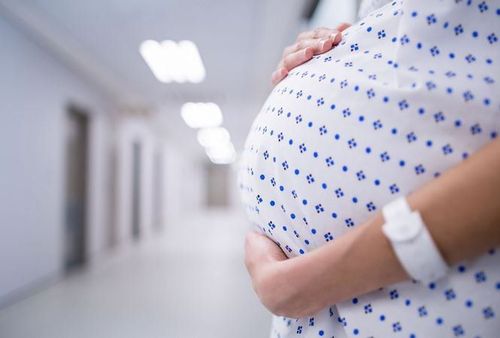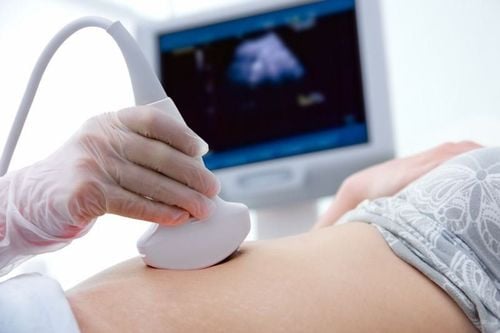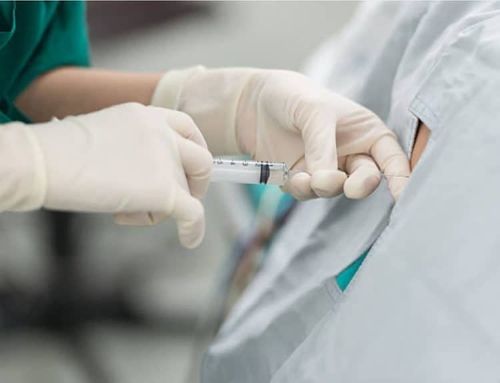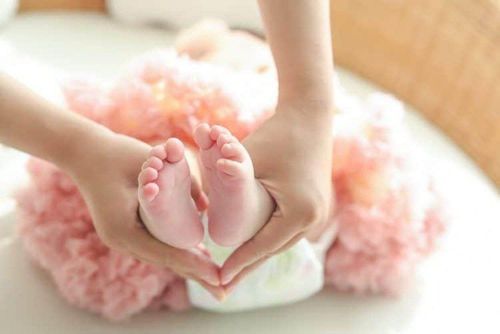This is an automatically translated article.
The article was professionally consulted by Specialist Doctor II Bui Thi Thu and Specialist Doctor II Tran Thi Mai Huong - Department of Obstetrics and Gynecology - Vinmec Hai Phong International General Hospital.After 9 months of pregnancy, labor is the last difficult stage that a woman has to go through to see her baby. Giving birth causes the mother to lose a lot of blood and strength, especially in the 3rd stage of labor. Therefore, active handling of this period helps to prevent postpartum haemorrhage.
1. Stage 3 of labor
Labor is a physiological process that causes the fetus and its appendages (the placenta, the amniotic membrane and the umbilical cord) to be removed from the mother's genital tract. A labor always includes 3 stages as follows:
Stage 1: Cervical dilation, calculated from the first contraction to when the cervix is fully dilated. Stage 2: Pregnancy stage, calculated from the time the cervix is fully dilated until the fetus is completely expelled. This is the result of increased intrauterine pressure during each contraction along with the effective pushing of the mother. Stage 3: Placement phase: is the stage from after the placenta is separated until the placenta is completed. The third stage of labor, also known as placental abruption and hemostasis, is the time from the delivery of the placenta to when the placenta is shed and expelled from the vagina. The average time of the entire period of placental abruption and hemostasis is about 6-30 minutes in the absence of external interventions.
Physiologically, stage 3 is also divided into 3 phases:
Placental abruption: It is the period from the time the placenta is delivered until the placenta is completely removed from its attachment position on the uterus. After pregnancy, the uterine cavity becomes empty, the uterus shrinks, at the same time, because the placenta is not elastic, it will be pinched and partially peeled off from its attachment position on the uterus. bow. At the site of sloughing, the pregnant woman's blood vessels are open, causing bleeding into the spaces, creating a posterior hematoma. The blood continues to flow, causing the hematoma to enlarge and spread, separating the remaining parts of the placenta from the site of attachment, until the placenta is completely detached from the wall of the uterus. Placenta : is the time when the placenta has completely shed, moving from the uterine cavity to the outside. During the period of hematoma formation, there is no contraction of the uterus, which is called the physiological rest of the uterus during the third stage of labor. After the break, the uterus begins to contract again, under the effect of the contraction, the entire placenta that has been removed will be expelled from the uterine cavity to enter the vagina. Hemostasis: is the period from the time the placenta is expelled from the uterus to the vagina until the bleeding stops completely. There are two mechanisms of hemostasis: Mechanical hemostasis, which is ensured by contraction of the uterine muscle causing constriction of the open blood vessels. The uterine muscle is made up of sphincter, longitudinal, and criss-cross muscle fibers. Contraction of the criss-cross muscle bundles in the body of the uterus tightens the blood vessels and ensures mechanical hemostasis. Mechanism of hemostasis by a blood clot that seals the ends of an open blood vessel. After mechanical hemostasis is hemostasis by a blood clot, the hemostasis will be completed by a normal coagulation mechanism.
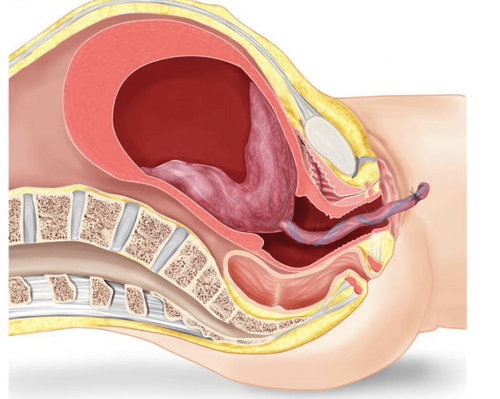
2. Actively handling the 3rd stage of labor
Active handling of the 3rd stage of labor is the proactive actions of the midwife in the period after delivery to help the placenta detach and deliver the pregnancy faster, in order to prevent postpartum bleeding.
Active management of the 3rd stage of labor is indicated for all lower births, when the fetus has just been delivered and there are no more fetuses in the uterus.
2.1 Steps to take
Then 1. Use Oxytocin immediately:
After the birth, the baby cries well, puts the baby on the mother's belly, which is already spread, and the mother holds the baby with both hands. The midwife palpates the woman's abdomen to make sure there is no pregnancy in the uterus. The midwife administers an intramuscular injection of 10 units of Oxytocin into the anterior thigh of the pregnant woman. Only after oxytocin was injected, the midwife carried out the pairing of the umbilical cord and cut the umbilical cord for the baby. When the umbilical cord pairs, pay close attention to the mother's vulva. The midwife brings the baby to the table to make the umbilical cord and take care of the baby, quickly dry, suck the oil, make the umbilical cord, wrap the baby in diapers and give the baby to the mother for early breastfeeding if appropriate. Then 2. Controlled pulling of the umbilical cord to induce placental abruption:
The midwife stands beside or between the mother's legs to perform the following tasks:
Place her hand on the woman's lower abdomen to assess uterine contractions . Only when the uterus has contracted well (like a grapefruit) can the next steps be taken. One hand holds the pin and the umbilical cord. Keep the umbilical cord taut. The other hand is placed on the mother's abdomen just above the scapula, holding and pressing the uterus in an upward direction towards the sternum while the hand holding the umbilical cord clamps pulls with moderate force and pulls in the direction of the delivery mechanism ( pull down at first, then horizontally and finally up). This movement is to prevent uterine inversion and to allow the placenta to follow the direction of the curvature of the pelvis. When the placenta has come out of the vaginal opening, the hand holding the umbilical cord is lowered to let the weight of the cake come out and pull the membrane out. If the membrane does not come out, the two people's hands hold the vegetable cake to twist in one direction so that the vegetable membrane comes out. If pulling the umbilical cord for 30-40 seconds but the placenta does not fall low (ie, there is no sign of placental abruption), stop pulling the umbilical cord again. At this point, just hold the umbilical cord and wait for the uterus to contract again. Continue to repeat moderate umbilical cord pulling along with reverse uterine compression during contractions. When pulling, if the umbilical cord is long, difficult to manipulate, you can roll the umbilical cord into the pin (clamp the umbilical cord) to shorten it, if necessary, use the pin to clamp the umbilical cord close to the vulva. Note:
Pulling the umbilical cord should not be done too rough. Do not pull the umbilical cord without using a second hand to push the uterus in an upward direction toward the sternum.
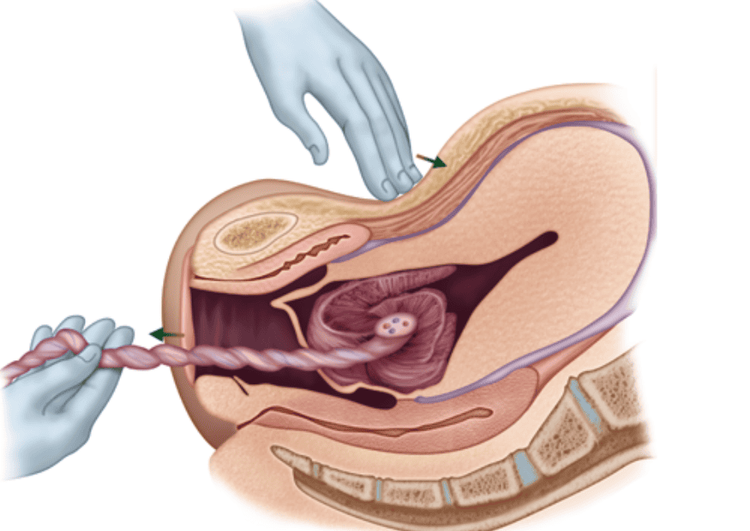
Then 3. Rub the uterus:
Immediately after the placenta must rub the uterus until the uterus is tight. Massage the uterus once every 15 minutes for the first 2 hours Make sure the uterus is still contracting well after the uterine massage is finished. 2.2 Monitoring
The midwife checks the placenta, the vegetable membrane to make sure there are no vegetables or membranes left. If bleeding continues, other possible causes of postpartum haemorrhage (genital tract tear, placental rupture) should be sought and appropriate treatment instituted for each cause. If there is only 1 doctor/midwife involved in delivering the baby, the steps are taken until the pregnancy is completed, the midwife hands the baby over to the mother while preparing to collect the vegetables. Steps to take vegetables continue to proceed as directed until vegetables and vegetable film have come out. At this time, the midwife instructs and supervises the mother to massage the uterus every 15 minutes through the abdominal wall until the uterus contracts well. The midwife makes umbilical cords and clothes for the newborn and places the baby on the mother's belly for early breastfeeding.
At Vinmec International General Hospital, there is a package maternity service as a solution to help pregnant women feel secure because of the companionship of the medical team throughout the pregnancy. When choosing Maternity Package, pregnant women can:
The pregnancy process is monitored by a team of qualified doctors Regular check-up, early detection of abnormalities Maternity package helps to facilitate the process. birthing process Newborns get comprehensive care
Please dial HOTLINE for more information or register for an appointment HERE. Download MyVinmec app to make appointments faster and to manage your bookings easily.
Reference source: Decision on promulgating Guidelines on technical process of medical examination and treatment specialized in Obstetrics and Gynecology - Ministry of Health.





